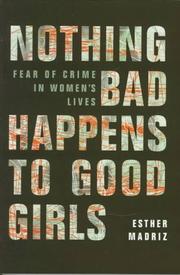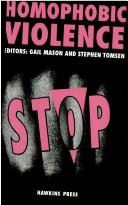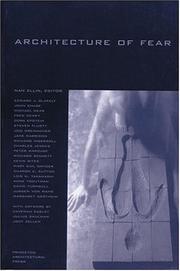| Listing 1 - 10 of 23 | << page >> |
Sort by
|

ISBN: 0429912579 0429898347 0429473575 128312520X 9786613125200 1849402280 9781849402286 1855751410 9781855751415 Year: 1997 Publisher: London : Karnac Books,
Abstract | Keywords | Export | Availability | Bookmark
 Loading...
Loading...Choose an application
- Reference Manager
- EndNote
- RefWorks (Direct export to RefWorks)
Robert Langs argues that death anxiety is neglected - in part, because of treatment failures due to countertransference interferences during treatment. He then discusses the technical issues connected with this, whilst introducing the controversial concept that mental activities are derived from immune system activities.
Fear of death. --- Psychotherapy. --- Death --- Psychological aspects.
Article
Abstract | Keywords | Export | Availability | Bookmark
 Loading...
Loading...Choose an application
- Reference Manager
- EndNote
- RefWorks (Direct export to RefWorks)
Aggression. --- Animal welfare. --- Diagnosis. --- Dog. --- Dogs. --- Fear-motivated aggression. --- Therapy.

ISBN: 0719048664 071905205X Year: 1997 Volume: *2 Publisher: Manchester : Manchester university press,
Abstract | Keywords | Export | Availability | Bookmark
 Loading...
Loading...Choose an application
- Reference Manager
- EndNote
- RefWorks (Direct export to RefWorks)
History of civilization --- History of Europe --- anno 1500-1799 --- Fear --- Peur --- Social aspects --- History. --- Aspect social --- Histoire --- Europe --- History --- 1492 --- -Fear

ISBN: 0520208552 Year: 1997 Publisher: Berkeley (Calif.) University of California Press
Abstract | Keywords | Export | Availability | Bookmark
 Loading...
Loading...Choose an application
- Reference Manager
- EndNote
- RefWorks (Direct export to RefWorks)
AMERICAN SOCIETY -- 343.97 --- CRIMES AGAINST WOMEN -- 343.97 --- FEAR OF CRIME -- 343.97 --- SOCIAL CONTROL -- 343.95 --- Fear of crime --- Women --- Crimes against --- Attitudes. --- Psychology.

ISBN: 1876067047 Year: 1997 Publisher: Annandale Hawkins press
Abstract | Keywords | Export | Availability | Bookmark
 Loading...
Loading...Choose an application
- Reference Manager
- EndNote
- RefWorks (Direct export to RefWorks)
Gays --- Homophobia --- Violence against --- Anti-gay bias --- Anti-GLBT bias --- Anti-homosexual bias --- Anti-LGBT bias --- Antigay bias --- Discrimination against gays --- Fear of gays --- Fear of homosexuality --- GLBT bias --- Homonegativity --- Homophobic attitudes --- Homoprejudice --- Lesbophobia --- LGBT bias --- Sexual orientation discrimination --- Discrimination --- Phobias --- Heterosexism --- Gay people --- Gay persons --- Homosexuals --- Persons

ISBN: 0520918967 0585047685 9780520918962 9780585047683 0520202910 0520208552 Year: 1997 Publisher: Berkeley University of California Press
Abstract | Keywords | Export | Availability | Bookmark
 Loading...
Loading...Choose an application
- Reference Manager
- EndNote
- RefWorks (Direct export to RefWorks)
"The possibility of being a victim of a crime is ever present on my mind; thinking about it as natural as breathing."--40-year-old woman This is a compelling analysis of how women in the United States perceive the threat of crime in their everyday lives and how that perception controls their behavior. Esther Madriz draws on focus groups and in-depth interviews to show the damage that fear can wreak on women of different ages and socioeconomic backgrounds. Although anxiety about crime affects virtually every woman, Madriz shows that race and class position play a role in a woman's sense of vulnerability. Fear of crime has resulted in public demand for stronger and more repressive policies throughout the country. As funds for social programs are cut, Madriz points out, those for more prisons and police are on the increase. She also illustrates how media images of victims--"good" victims aren't culpable, "bad" victims invite trouble--and a tough political stance toward criminals are linked to a general climate of economic uncertainty and conservatism. Madriz argues that fear itself is a strong element in keeping women in subservient and self-limiting social positions. "Policing" themselves, they construct a restricted world that leads to positions of even greater subordination: Being a woman means being vulnerable. Considering the enormous attention given to crime today, including victims' rights and use of public funds, Madriz's informative study is especially timely.
Women --- Fear of crime --- Social Welfare & Social Work --- Social Sciences --- Criminology, Penology & Juvenile Delinquency --- Crime --- Crimes against --- Psychology --- Attitudes --- Psychology. --- Attitudes. --- abuse. --- anxiety. --- bad victims. --- conservative politics. --- crime. --- criminal justice. --- criminology. --- culpability. --- danger. --- fear of crime. --- fear. --- female victims. --- feminism. --- feminist theory. --- gender hierarchy. --- gender studies. --- gender. --- good victims. --- law and order. --- legal system. --- media. --- nonfiction. --- patriarchy. --- potential victim. --- poverty. --- risk management. --- social justice. --- social programs. --- social science. --- subservience. --- threat perception. --- threat. --- victims rights. --- victims. --- violence against women. --- vulnerability. --- women. --- womens issues. --- womens studies.

ISBN: 9021484196 Year: 1997 Publisher: Amsterdam Querido
Abstract | Keywords | Export | Availability | Bookmark
 Loading...
Loading...Choose an application
- Reference Manager
- EndNote
- RefWorks (Direct export to RefWorks)
Thematology --- 82-312.9 --- Aesthetics, Modern --- -Aesthetics, Modern --- -Horror --- Horror in art --- Emotions --- Fear --- Modern aesthetics --- Fantastische literatuur --- Horror in art. --- Horror. --- 82-312.9 Fantastische literatuur --- Horror --- Aesthetics --- History
Book
ISBN: 2130482740 Year: 1997 Volume: *7 Publisher: Paris : Presses universitaires de France,
Abstract | Keywords | Export | Availability | Bookmark
 Loading...
Loading...Choose an application
- Reference Manager
- EndNote
- RefWorks (Direct export to RefWorks)
Emoties --- Emotions --- Feelings --- Gevoelens --- Human emotions --- Passies --- Passions --- Sentiments --- Émotions --- Émotivité --- Emotions (Philosophy) --- Political science --- Political ethics --- Fear --- Hope --- Happiness --- Emotions (Philosophie) --- Science politique --- Morale politique --- Peur --- Espérance --- Bonheur --- Philosophy --- Philosophie --- Espérance
Book
ISBN: 3476451895 Year: 1997 Publisher: Stuttgart M und P
Abstract | Keywords | Export | Availability | Bookmark
 Loading...
Loading...Choose an application
- Reference Manager
- EndNote
- RefWorks (Direct export to RefWorks)
Courage in literature --- Epic poetry, Greek --- Fear in literature --- Greek drama (Tragedy) --- Greek literature --- Heroes in literature --- Invective in literature --- Motivation (Psychology) in literature --- History and criticism --- History and criticism --- History and criticism --- Homer.

ISBN: 9781568980829 1568980825 Year: 1997 Publisher: New York (N.Y.) Princeton architectural press
Abstract | Keywords | Export | Availability | Bookmark
 Loading...
Loading...Choose an application
- Reference Manager
- EndNote
- RefWorks (Direct export to RefWorks)
Architecture --- Architecture and society. --- Fear. --- Architecture et société --- Peur --- Psychological aspects. --- Aspect psychologique --- 72.01 --- 159.9 --- angst --- 159.942*2 --- Architectuurtheorie --- Architectuur (theorie) --- Architectuur (esthetica) --- Architectuuresthetica --- Psychologie --- Architectuurtheorie. Bouwprincipes. Esthetica van de bouwkunst. Filosofie van de bouwkunst --- Angst --- 159.942*2 Angst --- 72.01 Architectuurtheorie. Bouwprincipes. Esthetica van de bouwkunst. Filosofie van de bouwkunst --- Architecture et société --- Architecture and society --- Fear --- Fright --- Emotions --- Anxiety --- Horror --- Environmental psychology --- Architecture and sociology --- Society and architecture --- Sociology and architecture --- Psychological aspects --- Human factors --- Social aspects --- 72.01 Theory and philosophy of architecture. Principles of design, proportion, optical effect --- Theory and philosophy of architecture. Principles of design, proportion, optical effect
| Listing 1 - 10 of 23 | << page >> |
Sort by
|

 Search
Search Feedback
Feedback About UniCat
About UniCat  Help
Help News
News